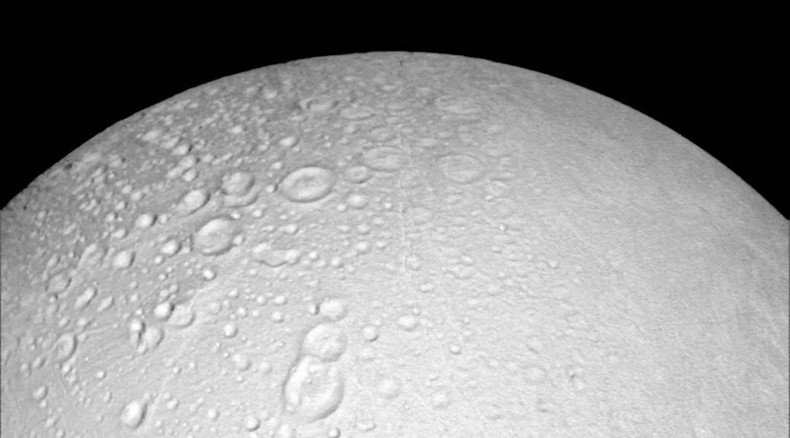NASA to make ‘deepest-ever’ dive into icy plume on Saturn’s Enceladus moon

The Cassini probe is set to make its deepest-ever dive through a plume of ice that Saturn’s Enceladus moon sprays into space. It is hoped that the flyby will give NASA new clues about what goes on in the ocean on the moon’s surface and whether it can support life.
Cassini will hover just 30 miles (49 kilometers) above the moon’s south polar region at 3:22pm GMT Wednesday. The spacecraft will capture some of the highest-resolution views of the icy south polar terrain NASA ever had.
But what is more important for scientists is that Cassini will sample an extraterrestrial ocean.
“This incredible plunge through the Enceladus plume is an amazing opportunity for NASA and its international partners on the Cassini mission to ask, 'Can an icy ocean world host the ingredients for life?'” Curt Niebur, Cassini program scientist at NASA Headquarters in DC said.
Saturn moon has subsurface ocean that covers entire body – NASA http://t.co/ZquJUJPrSFpic.twitter.com/0T99354n9J
— RT (@RT_com) September 16, 2015The probe is expected to provide answers to numerous questions about how habitable the ocean environment is on Enceladus.
“Confirmation of molecular hydrogen in the plume would be an independent line of evidence that hydrothermal activity is taking place in the Enceladus ocean, on the seafloor,” said Hunter Waite, INMS team lead at Southwest Research Institute in San Antonio, according to NASA.
Presently researchers are not sure for how long Enceladus might have been active and how much icy material is actually being sprayed into space.
“The amount of hydrogen would reveal how much hydrothermal activity is going on,” Waite said.
In May, US researchers suggested that the subsurface ocean on Saturn’s icy moon is similar in makeup to some of the life-bearing salt lakes on Earth.
They speculated that the ocean on Enceladus could be salty and had a basic pH of 11 or 12, with a neutral pH being 7, which let them believe that it could be the place to search for alien life in our solar system.
Cradle of alien life? Ocean on Saturn moon resembles habitable lakes on Earth http://t.co/4iw05UWKHWpic.twitter.com/qWC6xV5VaV
— RT America (@RT_America) May 9, 2015Cassini is also equipped with a cosmic dust analyzer (CDA). This instrument can identify up to 10,000 particles per second. It should help NASA analyze the chemical make up of the plume that Saturn’s Enceladus moon releases into space.
“There’s really no room for ambiguity,” said Sascha Kempf, a CDA team co-investigator at the University of Colorado at Boulder. “The data will either match what our models are telling us about the rate at which the plume is producing material, or our concept of how the plume works needs additional thought.”
Large sea found deep under ice on Saturn moon http://t.co/KBFDFoVu6Ppic.twitter.com/1xSilA0lgu
— RT America (@RT_America) April 3, 2014The Wednesday flyby will not be the closest Cassini has ever approached Enceladus, but it will definitely be the deepest dive. The closest that spacecraft ever came to Saturn’s moon was in October 2008 at an altitude of 16 miles (25 kilometers). However, at the time it passed through the plume at a much higher altitude than it will on Wednesday.
Launched by NASA in 1997, Cassini entered Saturn’s orbit in 2004. The mission to Saturn has yielded great discoveries about Enceladus. Icy plumes were first detected in 2005, and that led to discoveries of material gushing from warm fractures near its south pole.












